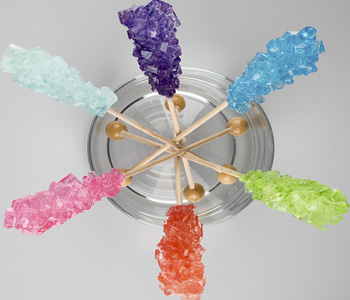Light Touch
Edible Optics
Five years have passed since Stephen R. Wilk wrote about edible lasers for OPN. This month he takes a look at edible optics—lenses, prisms, films and even optical fibers made of sugar and salt.
 Rock Candy: Most people are familiar with rock candy, which is polycrystalline sucrose with individual crystals measuring a few millimeters on a side. However, larger crystals of 10 – 20 mm can be seen in some samples. In the August 1951 issue of The International Sugar Journal, I uncovered a report of a seven-pound crystal, which took 14 years to grow from solution. Unfortunately, only the center inch or so was optically clear [Thinkstock].
Rock Candy: Most people are familiar with rock candy, which is polycrystalline sucrose with individual crystals measuring a few millimeters on a side. However, larger crystals of 10 – 20 mm can be seen in some samples. In the August 1951 issue of The International Sugar Journal, I uncovered a report of a seven-pound crystal, which took 14 years to grow from solution. Unfortunately, only the center inch or so was optically clear [Thinkstock].
Not too long ago I found myself thinking about the candy glass used in moviemaking. It’s a brittle sheet of transparent sugar used in place of real glass, usually for stunts. When broken, candy glass is less likely to cause injuries than regular glass—and it’s edible. It got me wondering about other edible materials that could be used to make visible optical elements.
…Log in or become a member to view the full text of this article.
This article may be available for purchase via the search at Optica Publishing Group.
Optica Members get the full text of Optics & Photonics News, plus a variety of other member benefits.
